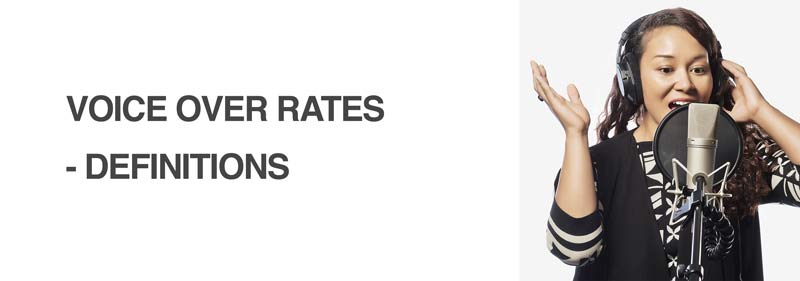Voice over rates are one of the most discussed topics in the voiceover industry. That’s why we have put together this guide on voice over rates for you. Voice over pay rates are determined by many factors.
This guide will give you a complete overview of what influences voice over rates, typical voice over rates in the industry and some considerations for how you should apply rates as a voice over artist.
First of all let’s dismiss the obvious – there is no such thing as a standard rate, there are only guide lines and even these vary by Country and type of work. The only standard rates are those set by some Union scale rates. One of the most notable differences is that between voice over union rates and voice over rates non-union. Unions provide a standard voiceover rate and therefore you can safely rely on the unions guide (depending on which Country you are in). However, non union voice over rates vary enormously and are often down to negotiations between the voice over actor and the client.
Voice Over Rates – The Basics
If you are looking at how to become a voice over actor, you will need to understand how voice over rates are set.
WHAT WE COVER IN THIS VOICE OVER RATES GUIDE
#1 – Definitions On Voice Over Rates You Need To Know
#2 – What Influences Voice Over Rates
#3 – Approach It As A Business
#4 – Adding Value To Clients
#5 – Union vs Non-Union Voice Over Rates Explained/a>
#6 – Voice Over Rates Tables To Guide You
Some Background On Voice Over Rates
Historically when you look at the SAG-AFTRA model rates were set by the guild and people had to abide by them.
#1. Global Market
You don’t need to be in New York or you don’t need to be in LA or Chicago. You can literally be anywhere in this country or in this world and start a voice over business. The advances in home recording technology and the internet have now made it easy to produce studio quality recordings at home.
#2. Shift in Technology
This shift in technology and the growth of sites like Voices.com have made voice over production a lot cheaper. Secondly, the number of people in the industry has grown and it is now a global market. Although, regional languages and accents still play a major role.
It is easily accessible as a professional career. Which is why more and more people do it. The market is growing as well as industries continue to move to digital media.
A Possible Future
Now whilst prices in the market have dropped I think there will be a change as prices/rates stabilise. Already you can see that taking place. This is driven by many people not being able to sustain a full living out of voice over and so rates may go up again, particularly for those that have a good pedigree of work and experience.
Definitions On Voice Over Rates You Need To Know
- Buy-Out: a flat rate which “buys” the right to use your voice, in other words they own the result of the work. All non-union jobs are considered “buy-outs.”
- Monthly Retainer: An agreement in which the client pays a set amount each month to compensate you for on-going work. The rate should be based on the average amount of work per month. We strongly encourage you to set a maximum amount of work the client is allowed to ask for each month at that rate.
- Per Hour: charging an hourly rate based on the length of time you spend at the studio.
- Per Project: charging a flat rate for a script, regardless of the time spent at the studio.
- Per Session: charging a flat rate for the recording session (the time you spend in the studio) regardless of the number of projects recorded.
- Per Spot: charging a flat rate for each commercial spot, regardless of the time spent at the studio.
- Residuals: Additional compensation for a commercial, above and beyond the initial payment, based on the number of times a spot is run. Paid every 13 weeks. This occurs in SAG or AFTRA (Union) commercials only.
- Scratch Track: a temporary recording that is a “place-holder” for the final voice-over. Not recorded as “broadcast quality” sound. Production facilities use scratch tracks to assist them with designing TV/video/flash presentations.
- Session: the time spent at a recording studio on one given trip. If you leave the studio and come back on a different day, even if you continue to work on the same project, it is a new “session.”
- Union Rates: The negotiated minimum rates for union voice-over work which union members should follow. The two unions governing voice-over are SAG AFTRA.
What Influences Voice Over Rates – An Explainer
So the next question is how do voice over rates vary and what influences them. It is impossible to account for every single variable. The different parts though that matter most are listed below.
By far and away the most complicated area for rates is in commercial work and the rate will vary according to:
- The size of the project – a long project with regular work can mean you pitch a lower rate. In business terms you are being more productive and spending less time in getting new business so it is more profitable.
- The size of the client – getting work with a well known brand, locally or nationally, will help you with your portfolio.
- The chances of getting more repeat work from the client – if you the client wants to have a consistent voice for their work they may discuss this as an opportunity.
- How the work is to be produced – do you need to be in a studio and travel or use a home studio.
- How the work is produced over time – is it spread out with a few hours over several weeks or is it a chunk of work that over a series of full days.
These are considerations that you need to take into account for jobs. Of course for pay to play sites much of the work is home studio based.
In contrast to commercial work narration (with the exception of broadcast narration for TV) is more predictable and easier to calculate. The rate for narration is calculated like this:
Total Word Count divided by 160 (the rate at which I read a minute of audio) = Total Minutes of finished audio, or edited, mastered and delivered to client.
Often it is important to initially determine some loose rates based on where you are. As an example you might ask yourself:
- Is this going to take me five minutes?
- Do I need the money – is there a gap in my workload?
- Is this creatively challenging?
- Does this build my portfolio of work?
The point is each person can often have a different perspective on how they ‘bid’ for work. Another factor is how you work within an industry if you have a really high profile. For instance if a big car manufacturer chooses you, you’re not going to get any kind of work from any other car manufacturer so you’re alienating yourself out of the rest of the market for the big players.

Approach It As A Business
Part of the challenge of becoming a voice actor is learning the skills involved in managing yourself as a business in the voice over industry.
Now what casting directors know what they want and often they are looking for voice over talent who can be their production partners and that involves having involves a quality studio.
As a voice over actor you need to be able to respond quickly in the way that I need to casting projects, often within hours.
How much will I make in my first year?
As a business you need to work out what you need to live on, that depends on many factors. But an important part of voice over acting is understanding your investments. This is not just equipment, but also developing your skills. This investment will pay dividends as you get more work and at a better rate.
If voicing becomes your full time occupation, you need to spend a lot of time, a lot of your days doing auditions. It’s a numbers game.
Realistically as a voice over actor you make between who can’t make $50k – $100k by using online casting sites and local agents and of course hustling for work on your own. That’s right, you need to hustle. I often hear voice over actors say that they they are not good at marketing or selling. Yet every business owner has to do this to make money. So learning these skills can make a big difference to your earning potential.
The rates you charge then will ultimately be determined not just by competition, your talent, experience and skills but also the type of income you’re looking for.
There are there things to think about then:
- Understand the costs involved in your business – the studio, equipment, travel…
- Understand what is realistic vs your experience and where you are sourcing your work
As a word of caution I would say you have to respect your life circumstances. Keep your life circumstances in full focus and perspective when you’re starting out. You know, if you’re coming from a minimum wage job, or if you’re coming out of
college, keep your life circumstances and understand you how to set some realistic goals.
However, by researching, practicing and developing your skills you can steadily improve the rates you charge.

Adding Value To Clients
When surveyed clients often list price as less important to them than the voice quality (fit to their brief), the recording studio quality, the time of turnaround…The point is that they want people that are reliable and can add value not just through their voice but also in the production stages and the speed at which they adapt to the client brief.
For voice over actors you need to be able to build in the other skills that clients value.
Clients New To The Industry
Some clients are not experienced in voice over. So another way you can help them is to advice then and help them really understand all that goes into a voice over recording to get it to the final polished result. Of course you need to take this into account when you charge for your time and again whether this is a one off project or has potential to be a long term client.
As a voice actor you are ultimately aiming to balance getting new clients with maintaining and developing business with existing clients. That involves building relationships, spotting new opportunities and using selling skills to get referrals.
Developing Your Technical Skills
In the ‘old days’ voice over actors used to walk into studios to record and there were three or four people behind the glass, you know, somebody keeping track of the script, a director; sound engineer…all these people cost money. Well, now all those people are just you, just one person in a room and so you have to learn to be a have full end to end production capabilities.
You’re an engineer, you’re keeping track of the copy, you’re your own director, you’re your own technician. Everything that is needed is – centres around you and you’re the one responsible for it. Now you can outsource some of this but that costs.
It is better to learn the skills yourself which in turn improves your turnaround time and expertise.
Rates and Level of Experience
As a beginner you need to start building all those little low rate jobs that help you get your experience.
You could be working making $7.00 an hour and busting – you know, doing eight, ten hours a day or you could get $100.00 job and feel great that it took you maybe 30 minutes, an hour to do. the important point is take your own situation into
account and is this the first job you’ve ever had or the first job you’ve ever received doing voice over? You have no other work.
If your tarting out doing three hours of work for fifty dollars then why wouldn’t you do it? Why wouldn’t you
get that first job under your belt?
It may not seem much but you got your first job, you’ve established a relationship with a company. They could come back and hire
you again. So you know, you got to be flexible. If you truly love doing voice over work then keep that love and that art and
that passion in perspective and don’t let that go.

Union vs Non-Union Voice Over Rates Explained
Unions aren’t present in every country, but they certainly are in the US and the UK. Unions are a collective that charge a membership fee, but undertake to set standard fees for work done and therefore protect voice over rates of pay.
Union rates are predetermined and apply to everyone in the union, while non-union rates are individual choices. Union rates are most often set as minimums, not maximums.
Sometimes you will be paid more by setting your own minimum or maximum rates. Being part of a union can make good sense, because of the standard rates you are not forced to go low and therefore lose out on revenue. However, remember that the online environment promotes an open market.
Union and non-union jobs have always been two separate markets. Non-union work is more visible and attractive today when compared to years ago, due to online casting. The availability of professional talent for non-union work has led to a reshaping of the voice over industry. An open market means that each professional voice actor sets their own rate based on what they need to cover.
Both union and non-union have advantages and disadvantages; ultimately, it’s a decision that you, as a voice over actor, will have to make. Like everything else, it’s of critical importance that you do your research and weigh up the pros and cons. Seasoned pros will usually tell you it’s best to be a union member because, if you run into trouble, the union will fight your cause.
If you are new to voice over online markets allow you to gain valuable work experience. Whereas, Unions can be very competitive. If you join a union you may find that established voice over actors get the vast majority of work.
It’s equally important to realize that when you join a union, you pledge to no longer accept non-union work. The reason for this is solidarity: you stand together with your fellow members so that you can negotiate better working conditions and pay for all of you as a collective. It’s worth noting, however, that a union in any given country only functions within the borders of that country and not beyond them.
Non-union work might generally pay less, but the online industry allows voice actors to do several jobs a day. Another consideration is getting paid. The chances of your being taken advantage of, or the agent taking a far higher commission that the industry average, are issues that you may be have to deal with.
Understand that once you’re committed, you’re committed. Given the inevitable transparency of the Internet, if you get caught doing non-union work as a union member, you personal brand and your reputation will take a devastating hit once it’s splashed on discussion forums and professional networks. ‘Naming and shaming’ is a popular tactic these days.
On the other hand as a non-union voice-actor, the chances are good that your talent will be unfairly exploited and you will always be paid less than you deserve while the client you work for makes all the money.

The Voice Over Rates Guide
As a guide to help voiceovers we have researched the industry, consulted with leading voiceovers as well as well-known v oice directors. We are proud to have put together a Voiceover Rates Guide
For more information on voice acting visit our series of posts on how to become a voice actor
[cp_popup display=”inline” style_id=”509696″ step_id = “1”][/cp_popup]
[social_warfare]


